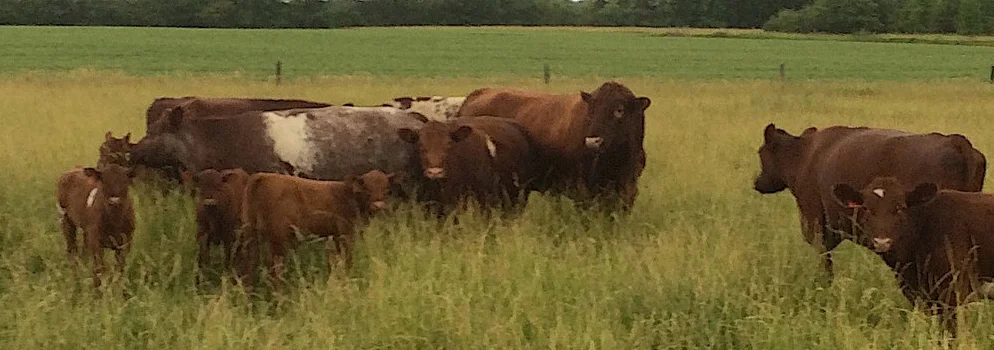Having a production-focused purebred cow herd is a challenging yet rewarding segment of the seedstock business to which Heritage/Native Shorthorn cattle are well suited.
I believe there are two primary and often competing responsibilities for the production-focused purebred breeder. First, they must be a preservationist. All purebred breeders active today have built their programs on the bloodlines developed by breeders of generations past. It is their duty to preserve this legacy for the generations of cattlemen to come. Second and by no means less important, it is imperative that seedstock cattle are produced that can become a viable component for the commercial beef cattle industry or for specific niche markets.
Our own Shorthorn breed history has shown us that balance between these two competing goals is crucial to the success of the breeding herd and even to the breed itself. Two prime examples of the consequences of not maintaining this balance would be what happened in the Shorthorn breed with the strains developed by Thomas Bates and Amos Cruickshank in the 1800’s. Both herds, though developed some 50 years apart, were built on strong production criteria and provided seedstock that led Shorthorns to cattle industry dominance. Unfortunately in both cases speculation caused lineage purity to overshadow quality which in turn led to diminished functionality and the near extinction of these strains, and even the breed itself. A disciplined approach to balancing these ideals in your breeding program is a necessity for maintaining or increasing the viability of your herd.
Upon acknowledging the dual responsibilities of preservation and commercial relevance, the next step is to pick your target market. Due to fragmentation, niche markets, and to many different environments, there are quite a wide range of markets available. Do more than just select a market. Take some time to study your potential customer’s needs. For example, if your customer is located in a harsh environment with a low input type of operation, then a high milk production cow will not work for them. If however the herd is in an area of abundant feed then a heavier milking cow could be utilized to take advantage of these low cost inputs. It is all about helping your customer achieve optimum in their herd.
Try also to anticipate what their future seedstock needs might be based on their present breeding program and the signals that the market may be sending. A clear vision of your target market and the needs of this potential customer will be a valuable asset in the selection of the foundation stock for your herd as well as a vital factor in the success of your business.
(Commercial Beef) Shorthorn Bull “Kaper 4508”
(Commercial Beef) Shorthorn Bull “Wolf Ridge Frontline”
Having identified your target market you are ready to begin the search for your foundation breeding stock. As you go through this process it is important to always keep in mind this one important fact: Change takes time in the cattle business! For this reason it is very important to select foundation cattle as near to your perceived ideal as possible.
Aside from the basic but important considerations of soundness, phenotype, production, health, and data, there are some important questions that should be answered as you search out a potential source for your foundation cattle:
Does the breeder successfully supply breeding stock to cattlemen that mirror your target customer?
Do they raise cattle in a similar way to what you plan to? For example low input vs high input.
Is their breeding program long-term focused showing continuity and reliability? The pedigree can be of great assistance here. Does it show a succession of well planned matings designed to achieve the breeder’s goals? The other extreme would be a pedigree of haphazard matings which could indicate that the breeder has no clear goals, or that they have a “follow the fads” mentality.
Are they located in an environment similar to where your operation is located, or if not, have animals from their herd performed well in your environment?
Finding cattle that check as many of the boxes as possible is of great value. Buying them for your foundation herd can put you years ahead towards achieving your goals as opposed to starting with the wrong type or background.
With the successful purchase of your foundation seedstock you can begin the ongoing challenging process of improving and fine tuning your herd. Always keep in mind the vision you established at the founding of your herd and continuously be cognizant of your customers’ needs.
Shorthorns with Wolf Ridge Double Brute
I would like to end my thoughts on this process with an exclamation point of sorts. I have had an opportunity over the years to visit a variety of herds, many of which have been in existence for 50 years or more. A reoccurring theme in most all of these visits was the breeder pointing out an outstanding individual or group of animals purchased at the beginning of their career that became the basis for their success. It is my hope that you will someday be able to say the same.
Author Profile: Gary Kaper
Gary is a Registered Shorthorn breeder located in Watseka Illinois. He started his herd in 1973 and today the entire herd traces many times to the original cows purchased at the herd’s beginning. Over the years semen and breeding stock from this herd have been sold into 21 states, Canada, and Australia. Data collection has always been a priority and over the years several performance awards recognizing maternal efficiency have been received by individuals in his herd.
For more articles about cattle breeding, cattle selection and other management topics, please visit The Shorthorn Bulletin.




